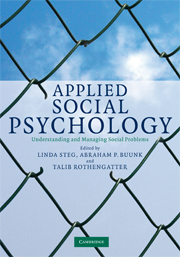Book contents
- Frontmatter
- Contents
- List of figures
- List of tables
- List of boxes
- List of contributors
- Acknowledgments
- 1 Introduction to applied social psychology
- 2 The USE of theory in applied social psychology
- 3 Applications of social psychology to increase the impact of behaviour-focused intervention
- 4 Research designs in applied social psychology
- 5 Social psychology and economic behaviour: heuristics and biases in decision making and judgement
- 6 Social psychology and immigration: relations between immigrants and host societies
- 7 Applying social psychology to the classroom
- 8 Social psychology and environmental problems
- 9 Gender issues in work and organizations
- 10 Social psychology of health and illness
- 11 Social psychology and mental health
- 12 Social psychology and modern organizations: balancing between innovativeness and comfort
- 13 Social psychology and the study of politics
- Index
- References
7 - Applying social psychology to the classroom
- Frontmatter
- Contents
- List of figures
- List of tables
- List of boxes
- List of contributors
- Acknowledgments
- 1 Introduction to applied social psychology
- 2 The USE of theory in applied social psychology
- 3 Applications of social psychology to increase the impact of behaviour-focused intervention
- 4 Research designs in applied social psychology
- 5 Social psychology and economic behaviour: heuristics and biases in decision making and judgement
- 6 Social psychology and immigration: relations between immigrants and host societies
- 7 Applying social psychology to the classroom
- 8 Social psychology and environmental problems
- 9 Gender issues in work and organizations
- 10 Social psychology of health and illness
- 11 Social psychology and mental health
- 12 Social psychology and modern organizations: balancing between innovativeness and comfort
- 13 Social psychology and the study of politics
- Index
- References
Summary
Introduction
The classroom is the core unit of our educational system. It also illustrates many common social-psychological concepts and phenomena. Whenever we bring groups of people together for the purpose of learning, we have the opportunity to apply social-psychological principles that will further our educational goals. Applying these principles to the classroom may help increase students' commitment to learning, make their attitudes towards school more positive, reduce their feeling of failure and related negative affects or emotions, improve their level of aspiration as well as their grades, and much more. Clearly, education is – at least in part – applied social psychology.
In the past three decades, more and more researchers contributed to bridging the gap between social psychology and education, resulting in the emergence of a new scientific area, the so-called ‘social psychology of education’, ‘educational social psychology’ or sometimes even ‘social educational psychology’. Is this area merely social psychology applied to a particular domain of interest? Or is it a subdiscipline of the field of education, looked at from the vantage point of the social psychologist? As noted by Feldman (1986), the most appropriate answer is that it represents an amalgamation of the two fields; it is not merely social psychology, nor is it simply education. Whatever it is called, this new area represents an interface of the two fields, which has produced a broad range of theories, research and data that speak to the interests of educators and psychologists.
- Type
- Chapter
- Information
- Applied Social PsychologyUnderstanding and Managing Social Problems, pp. 162 - 183Publisher: Cambridge University PressPrint publication year: 2008
References
- 3
- Cited by



